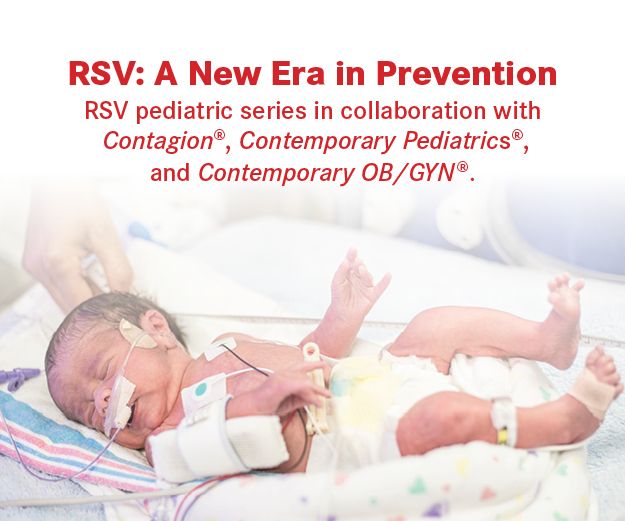CDC recommends nirsevimab immunization to prevent RSV in infants
The federal agency says infants of a certain age should receive this monoclonal antibody to protect against the virus.
CDC recommends nirsevimab immunization to prevent RSV in infants

This short series on RSV is a collaboration between Contagion, Contemporary Pediatrics, and Contemporary OB/GYN. Check back every week for additional stories and interviews with clinicians and key RSV stakeholders.
The CDC is now recommending all infants younger than 8 months, born during, or entering, their first RSV season (typically fall through spring) receive 1 dose of nirsevimab for protection against the virus. In addition, for a small group of children between the ages of 8 and 19 months who are at increased risk of severe RSV disease, such as children who are severely immunocompromised, a dose is recommended in their second season.
This action comes after the FDA approval and the CDC’s Advisory Committee on Immunization Practices’ (ACIP) recommendation for the use of nirsevimab this summer. The CDC Director Mandy Cohen, MD, MPH, has officially adopted the recommendation.
“This new RSV immunization provides parents with a powerful tool to protect their children against the threat of RSV,” said Cohen in a statement last month. “RSV is the leading cause of hospitalizations for infants and older babies at higher risk and today we have taken an important step to make this life saving product available.”
According to the CDC, 58,000-80,000 children younger than 5 years are hospitalized due to RSV infection annually.
Back in July, the FDA approved nirsevimab for the prevention of RSV lower respiratory tract disease (LRTD) in newborns and infants born during or entering their first RSV season, and for children up to 24 months of age who remain vulnerable to severe RSV disease through their second RSV season.
A few weeks later, the CDC followed-up and voted to recommend nirsevimab immunization. Nirsevimab has been called a ”passive immunization product” that is not a vaccine, but a monoclonal antibody, which has a different mechanism of action.
“I think this could be a game changer, because it could be a very effective way—based on the data that we learned from the clinical studies—[showing it was] very, very effective in preventing hospitalizations, and severe lung infections. So we hope this is going to be a major, major change,” explained Octavio Ramilo, MD, chair, Department of Infectious Diseases, St. Jude Children’s Research Hospital in a recent interview.
What the Data Demonstrated
The phase 3 MELODY trial (Trial 04) was a randomized, double-blind, placebo-controlled trial conducted across 21 countries designed to determine the safety and efficacy of nirsevimab against medically attended LRTD caused by RSV in healthy term and late preterm infants (35 weeks gestational age or greater) entering their first RSV season, including efficacy against severe disease such as hospitalization, through 150 days after dosing. The primary endpoint was met, reducing the incidence of medically attended RSV LRTD by 74.9% (95% CI 50.6, 87.3; P<0.001) compared to placebo. The efficacy of nirsevimab against the secondary endpoint of hospitalization was 60.2% (95% CI: -14.6, 86.2).
As previously reported in Contagion, additional trial data came from the HARMONIE phase 3b study. This trial recruited more than 8000 infants under 12 months of age across Germany, France, and the United Kingdom. The investigators compared a single intramuscular dose of nirsevimab (<5 kg 50 mg; ≥5 kg 100 mg) to no intervention, and found nirsevimab reduced hospitalizations due to severe RSV-related LRTD by 83.21%.
Additional data from the HARMONIE trial suggest nirsevimab reduced the incidence of hospitalizations due to severe RSV-related LRTD, defined by requiring oxygen supplementation, by 75.71%. Nirsevimab also reduced all-cause LRTD hospitalization by 58.04% compared to infants who received no intervention. Throughout the HARMONIE trial, and into the 12-month follow-up period, nirsevimab maintained a favorable safety profile.
According to the monoclonal antibody’s manufacturers’, Sanofi and AstraZeneca, the product will be available for distribution.
To learn more about women’s health, go to Contemporary OB/GYN; to learn more about pediatric health go to Contemporary Pediatrics; and to learn more about infectious disease, go to Contagion.
The Role of the Healthcare Provider Community in Increasing Public Awareness of RSV in All Infants
April 2nd 2022Scott Kober sits down with Dr. Joseph Domachowske, Professor of Pediatrics, Professor of Microbiology and Immunology, and Director of the Global Maternal-Child and Pediatric Health Program at the SUNY Upstate Medical University.
Overview of biologic drugs in children and adolescents
March 10th 2025A presentation at the 46th National Association of Pediatric Nurse Practitioners (NAPNAP) conference explored the role of biologics in pediatric care, their applications in various conditions, and safety considerations for clinicians.